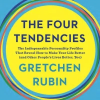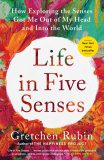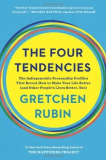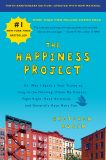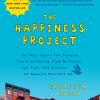

Very Special Episode: Top Tools for Habit Change
Many people use January 1 as a catalyst for habit change. But while people say “New Year, new you,” it’s really new year, same you! But we can fin better tools.
In my book Better Than Before I explore the 21 strategies we can use to make or break our habits, and suggest many tools to use.
If one approach or tool isn’t working, we can try something new. There are countless ways to achieve the same aim.
In this Very Special Episode, we highlight some of the most popular, effective tools. Each of these tools is available in the Happier app, or if you prefer tangible tools, many are also available in physical form.
Don’t Break the Chain — People really love streaks. You can find this tool in the Happier app or you can use the physical Don’t Break the Chain Journal. Or, like Elizabeth, you can use both the app and the Journal!
But remember: What we do most days matters more than what we do once in a while.
Numbers Tracker to log steps, minutes, pages etc. — People love to track their numbers.
One-Sentence Journal to record details you want to remember, such as books read, hikes achieved, recipes tried, running experiences, tasks accomplished.
This tool is also available in the Happier app and in physical form as the One-Sentence Journal. (The physical journal could make a good keepsake.)
Photo Log — probably the easiest tool, and also creative and satisfying.
Accountability Partners if you’d like to notify a friend, family member, coach, or group about your activities, or post on social media — This tool can be useful for anyone, but is a particularly popular tool for Obligers, (Note: for some Obligers, the app or the tool itself can be a form of accountability.)
Track Your Total to measure numbers that add up over time, such as miles, minutes, or words — Especially satisfying for people who love a “ta-da.”
Notifications — You get a reminder to work toward your aim.
Say you’re joining us for the “Go Outside 23 in 23” challenge, to go outside for 23 minutes each day in 2023. #Outside23in23. You can imagine how you might use any or all these tools toward that aim:
- Don’t Break The Chain
- Numbers Trackers
- One-Sentence Journal
- Photo Log
- Accountability Partners
- Track Your Total
- Notification
Remember, Rebels, you can do whatever you choose to do! Do whatever seems like the most fun, challenging, or satisfying.
Resources
If you’re trying to make (or break) a habit, you can use my “Checklist for Habit Change.” This one-page chart will help you deploy the many strategies for habit change.
If you’re joining us for #Outside23in23, post on Instagram, Facebook, or Twitter on your first day of the New Year for a chance to be re-posted. I can’t wait to see how people are engaging with this challenge!
What we’re reading
Gretchen:
Hello and welcome to Happier, a podcast where we talk about strategies, insights, and hacks about how to create happier lives. This week is episode 410, which means that it is a Very Special Episode and in honor of the New Year, when so many people are thinking about how to work on their habits, we will talk about the top tools for habit change.
[Music]
I’m Gretchen Rubin, a writer who studies happiness, good habits, the Four Tendencies, the five senses, and human nature. I am in Kansas City, my beloved hometown. Elizabeth, I wish you were here. And joining me today from L.A., not K.C., is my sister, Elizabeth Craft. Elizabeth, the Season 2 premiere of Fantasy Island airs January 2nd. I’m so excited.
Elizabeth:
Yes, that is me. Elizabeth Craft, a T.V. writer and producer living in L.A. and yeah, Gretch, everyone can catch up on Season 1 of Fantasy Island on Hulu. It’s a perfect winter escape binge, as we like to say. And then watch the premiere on January 2nd. And I’m so excited. Cheryl Hines and Rachael Harris are guest stars in the first episode and they’re so fantastic.
Gretchen:
You keep dropping all these hints, but you won’t disclose all the big plot points and stuff, so I’m going to be excited to watch with everybody else. Before we jump in, we got the most fun update about our one-word themes for the year.
Elizabeth:
This comes from Hannah, a listener in Sweden. She says, “In Swedish, your choice of words, Scale and Wave, is the same word. The word for the subject scale, an object used for scaling groceries, for example, is våg and the word for waves in the ocean is also våg. Amazing, and in some way magical. To think that you sisters picked sister words like that—I had to pause the listening of the episode to email you immediately.”
How cool is that?
Gretchen:
I know, Elizabeth, our one-word themes match up. And the funny thing is we are of Swedish descent. And so if we identify with anything, we identify with Swedish. And so it’s particularly satisfying that this coincidence happened in Swedish. So fun.
Elizabeth:
Very cool. Thank you, Hannah, for letting us know.
Gretchen:
And now for our Very Special Episode, we will review some of the top tools for habit change. Now you can change your habits at any time, of course, I know the Questioners out there are like January 1st is an arbitrary date. But it is often useful to use a clean slate as a catalyst for change. Or you just need something to remind you to step back and reflect and think about what changes you want to make for your life. And for a lot of people, that’s January 1st.
But while there is the phrase “New Year, new you,” it’s really “New Year, same you.”
Elizabeth:
Right?
Gretchen:
But you can have better tools. So in my book, Better Than Before, obviously, I talk about the 21 strategies we can use to change our habits. And I talk about tons of different tools that people use. And the reason that this matters is that research shows that about 40% of everyday life is shaped by habits.
So if we have habits that work for us, it’s a lot easier to be happier, healthier, more productive and more creative. So it can be useful to think about some of the most popular tools because some of the tools work really well for some people, but not for others. Some work at some times in our lives and not for others and in our lives.
And then some are like pretty widely useful. So we thought talking about these, these are also tools that are part of the Happier app. So if you’re using the Happier app, if you’re thinking about using the Happier app, these are tools that are part of that because they really do end up being some of the ones that seem to work for the most people most of the time.
Elizabeth:
Yes. And people like different approaches, Gretch. Some people like the Don’t Break the Chain. You can go through all the different approaches.
Gretchen:
Right. And so one thing to remember is if something isn’t working for you, try something new. Don’t blame yourself. I think a lot of times people get discouraged and they’re like, “Well, what’s my problem? Why can’t I use it to do this? Why can’t I just put something on the calendar? Why can’t I just sign up for a class? Why does that not work for me?”
A lot of times it’s like, there’s nothing wrong with you. It’s just that you need to try different tools. So as you’re thinking about these tools, think about, Well, have I tried some unsuccessfully in the past, so maybe I’ll try something new. Or I’ve used one of these tools with great success in the past. Maybe now I can try it with a different aim.
Because these tools can be used for all different aims. It just depends on what you want. And it is often helpful to think about what has or hasn’t worked in the past.
Elizabeth:
Speaking of my words, Scale, Gretchen, I know in the past when I weigh myself every day I get better and go in a direction I want to go in. And when I don’t do that, the opposite happens. And yet I have to learn that lesson over and over again. Which is why one reason why Scale is my word and why using the Happier app.
Gretchen:
Right. Well, and it also helps to know your Tendency.
Elizabeth:
Yeah.
Gretchen:
Because if you know your Tendency, then you can choose wisely from among the tools because you’re like, “Well, this is the kind of tool that probably work for me as an Upholder, Questioner, Obliger, Rebel.”
Or you might reframe a tool in a way that makes it more attractive to your Tendency. So again, if people don’t know what we’re talking about with the Four Tendencies, you can take the quiz. Go to gretchenrubin.com/quiz. It’s free. More than three and a half million people have taken the quiz and it will give you a little report.
And as we talk about the tools, we can talk about whether different Tendencies might be particularly attracted to certain tools.
Elizabeth:
Yeah. So let’s do talk about Don’t Break the Chain, which I just mentioned, because that is a huge tool, I think for Obligers, which I am.
Gretchen:
Yes. So it turns out Don’t Break the Chain is super popular in the Happier app. It’s the most popular tool or one of the top two most popular tools. I have the Don’t Break the Chain Journal for people who like to keep things on paper, that’s super popular too. Because like you say, a lot of it works really well for Oblivers who are able to use it as a form of utter accountability.
Some Obligers really need outer accountability from an actual person, but many Obligers are like you, where there can be a process or kind of a visible outcome that itself creates a sense of accountability. Because it’s like, I don’t want to be confronted with the fact that I’m not sticking to it. And so it creates the accountability.
Elizabeth:
Yeah. Gretchen, I have to tell you, I’m using the Don’t Break the Chain in the app AND the journal. I have a double just to make sure that I monitoring myself.
Gretchen:
And then also you get that feeling of satisfaction too, because you’re getting two checkmarks of like, I’m doing it here, I’m doing it there. It’s your growing ta-da list. It’s great.
Elizabeth:
Yes. No, exactly. And you know what I was thinking about with Don’t Break the Chain is I wonder if that’s part of why Wordle is so popular. We’ve talked about Wordle, which is the game where you have six chances to guess a word and they keep track of how many days in a row you can go.
And I’m like, “I know my highest streak is 82 and I never want to stop my streak.” So it keeps me playing every day.
Gretchen:
I mean, that’s the thing is people love streaks. Once you’ve got a streak going, it’s gets very compelling to keep that going. So Don’t Break the Chain is a tool that many, many people find to be really useful. I mean, one thing I would say about Don’t Break the Chain is you just want to keep in mind that what we do most days matters more than what we do once in a while.
And so if occasionally you have to, like take a break or take a day off, don’t make that feel so catastrophic that then that discourages you from starting up again because you’re like, “Oh, no, now I’m all the way back at one.” Because the real point of it is to do something most days. And so you don’t want to let Don’t Break the Chain actually get in the way.
I have seen some people get so invested in it that it becomes sort of unhelpfully painful.
Elizabeth:
Well, that’s like you, Gretch, you go to the Met every day and you being in an Upholder, I know you could get very focused on “I must go no matter what.”
Gretchen:
Well, and the thing is, it’s like if I fly that day, okay, I could race over there and just get in right before it closes because of when my plane lands. I’m like, “You know what, I’m just going to say I was traveling from out of town today. This just counts as a travel day, as an out-of-town day.” Right. And I had to make those kind of rules for myself as an Upholder. You’re exactly right.
Okay. Now, another extremely popular tool. It’s interesting using the app because you see what people actually do. So this is kind of like scientific research. People love a numbers tracker. You know, you can log steps, you can log minutes. It is a super popular tool and it functions to do a lot of things.
You see all the days you’ve done something, so it gives you that reinforcement. So like let’s say you were doing Go Outside 23 in 23, you would see every day you log 23 minutes outside. And so it could maybe show you patterns and give you that sense of reinforcement because like, “I did it, I did it, I did it, I did it.”
Elizabeth:
I love this was steps because I remember when Sarah and I first got our treadmill desk, which was your greatest gift to me ever be logged steps to the moon.
Gretchen:
Yeah, for that, hang on, because we’ll talk about another tool that helps with that kind of thing.
Elizabeth:
Oh, great.
Gretchen:
So the numbers tracker you’re tracking that you did like your 23 minutes that day. So that’s good if you’re doing it that way. But hang on to that because there’s a tool for that as well.
Elizabeth:
Oh, great. I can’t wait to hear about that. All right. Coming up, more tools. But first, this break.
[Music]
Elizabeth:
So Gretchen, okay, Track Your Total. I was just talking about like tracking your walk to the moon. Explain how this works.
Gretchen:
So Track Your Total is if you want to see numbers adding up over time. So it’s not just like, “Oh, I wrote 1500 words today,” it’s 1500, 3000, and you’re seeing it build up, whether that’s miles or minutes or words or whatever it is. So this is a growing heap where it’s not just like, what did I do day by day, but how is it growing?
And I think for people who do like things like “I’ve walked from New York City to Boston” or “I’ve gone to the moon,” that can be very exciting. I think for some people the numbers can get so big that they’re just sort of imaginary and you don’t feel like the number is changing. So they like seeing that day-by-day logging. But then some people really like to see the numbers mount up.
So again, this is something where it’s essentially the same thing. It’s the same process, but it’s reframing it in a way that might make it more or less useful to you or attractive to you. So again, it’s well, what appeals to your imagination? Because one of the things that’s really surprised me in the study of habits and just generally, and Elizabeth, we talk about reframing all the time, is like subtle changes can make a difference.
Subtle language changes like are you going to “practice piano” or are you going to “play piano” can end up making a big difference. And so the way that the numbers are presented might make something more accessible or exciting or imaginative or fulfilling for you. And so it’s just like, don’t just assume that, oh, this is how people do it.
It’s like, okay, you Questioners out there, I know you love customization. We all do. But especially Questioners. Think about, well, how do I want to tee this up in a way that’s right for me? And that like back to Don’t Break the Chain, you might say, “Well, how could a Rebel use Don’t Break the Chain?” It literally has chain in the title.
And if Rebels don’t like anything, they don’t like feeling chained or controlled or limited. But you can say but they love a challenge. They love to prove. They love to show their identity. And if you’re like, “Hey, people think I can go outside every day for 23 minutes in 2023? Well I’ll show them,” you know, “I want to show you the kind of environmentalist I am or like the kind of outdoor person I am” or whatever it might be.
Then they find that very exciting and satisfying because it’s like, okay, I’m going to show you here’s the challenge. I’m going to meet that challenge to do something every day. So again, for an Obliger, it can be the accountability. Whereas for the Rebel, it’s the challenge and the proof of the identity. Same tool, but it’s framed in a way that makes it appealing to different people.
So different people come to it with a different frame of mind.
Elizabeth:
Yes, I am a huge fan of reframing, as you know.
Gretchen:
Yes, you are. You’re always good at reframing.
Elizabeth:
Okay, great. We’ll talk about the One-Sentence Journal.
Gretchen:
The One-Sentence Journal is a very exciting tool. I think this is a very satisfying tool. This is really good for memorializers, I think, which is kind of outside the Four Tendencies, but for people who want to put a little color on what they’re doing. So if you want to record details about some habit that you’re working on, like maybe you’re trying to hike all the time, so you’re going to write what trail you were on.
So it’s like I did this one so many times and I tried these new ones. Maybe it’s recipes you’ve tried. Did you like them? Did you not like them? Maybe it’s the books you’ve read. And what I like about the One-Sentence Journal is, first of all, it helps you identify patterns so it can make it more exciting because you are adding that layer of detail.
And then it also can be a keepsake. You know, like I have a One-Sentence Journal, a physical one too. It’s in the app, the One-Sentence Journal, but there’s also a physical One-Sentence Journal. And this is something where, let’s say your habit was that you wanted to read aloud to your children every night before bed. Then you could have a record of all the days you read and what you were reading at the time.
Well, over the years, I would love to have a record of what I read to Eliza and Eleanor when they were little, because now Eleanor said to me, “Oh yeah, you read Little Women to me when I was little.” And I was like, “Are you kidding?” I must have taken like, how many months did that take? That is a long book.
I have no recollection of that whatsoever. I would love to be able to flip through a journal and see it. And I think for many people it kind of gives you more of a feeling of credit or more of a feeling of logging something. So if they open the app and they write down what hike they took, it sort of feels more real in a way or more satisfying. I see that with people.
Elizabeth:
Well, again it’s the ta-da of it all.
Gretchen:
Yes, it’s the ta-da. It’s 100%. It feels like more of I’m getting credit for this. Look at what I did. I have the sense of accomplishment. I can look back on this. I think that’s absolutely right. So again, it’s like, do you want the convenience of an app? Do you like the physical thing of a journal? Do you want to do both?
Elizabeth:
I even think, Gretch, taking that moment to write the sentence is a moment of mindfulness where you’re just taking a moment for yourself. It’s like checking in with yourself.
Gretchen:
100 percent.
Elizabeth:
Which I think is something from what I hear from listeners, a lot of people don’t do and want to do.
Gretchen:
Yes. Absolutely. I think that’s an excellent, excellent point. And it’s something to really think about. Like this is my moment of mindful reflection on what I’ve done. I think that’s a great point. Yes, absolutely.
So if you say that the One-Sentence Journal takes a tiny bit more effort because you’ve got to figure out what you’re going to say, the photo log, this is the one that is so easy.
It’s easy and it feels creative. You know, there’s something about taking a photo that feels creative and fun, and it’s fast. Now that we all have our phones with us all the time. It’s a great way to create a visual record of what you’re doing.
Elizabeth:
Yeah. And so is that something you can do in the app?
Gretchen:
Yes, you can do that in the app. So it’s a different way to keep a streak or record a journal, but it’s in a photo form. So let’s say you were trying to do go outside 23 and 23. You could do that and Don’t Break the Chain. You could do that in the One-Sentence Journal, but you could also do like I going to look for a beautiful tree and take a photo of it every time I go outside.
Or I’m going to take a picture of the same thing and watch it change over the year. Or I’m going to look for like, what’s the most interesting thing I can take a photograph of? So kind of a quest is more interesting than a jaunt. And so maybe look for things like, “Oh, what thing am I going to take a picture of?”
Could make your time outside more engaging and interesting. I think for a lot of people, this is fun.
Elizabeth:
Yes, I should take a picture every time I’m at the top of Fryman Canyon.
Gretchen:
Yeah, right. Because it’d be…
Elizabeth:
It would encourage me to go more often.
Gretchen:
Well, no, it would encourage you to go more often because you have that feeling of like, “Oh, it’s back to this idea of the ta-da.” Or “Oh, I’m excited to see what it looks like.” It’s sort of memorializing it. And then you have that record. And for many people that can be accountability because it’s like, “Oh, I need to take my photo.”
One of the things when I do at the Met is I take a picture of the Met every time, and that’s fun because I’m like, “Am I going to take it inside? Am I going to take it outside? Am I going to take this picture? Am I going to take that picture? Sometimes I’ll take many pictures, but then I always decide what’s my real picture of the day?
What’s the one I’m going to put into the app? Because I pick it from the gallery. So I might be like, I can take a picture of the floral arrangement. I might take a picture of something from a new exhibit I might take a picture of the holiday tree or whatever, or something in the gift shop, whatever it might be.
And so I sort of have that fun of… what is the name of that pleasure? It’s the pleasure of deciding what is the best thing. That’s just fun for me. It makes it a fun little quest.
Elizabeth:
Well, good. Well, yeah. I like the idea of being able to have a group of photos together that go together, right? Rather than just splattered on your phone.
Gretchen:
It’s a record. Okay. And now we got to talk about one of the biggest, most important… well, this is directly aimed at accountability. This is Accountability Partners. Now, because as we say all the time, if you are in an Obliger, what you need to meet an inner expectation is otter accountability. And there are so many ways to create out or accountability.
We’ve already talked about some things that can work as outer accountability, something like Don’t Break the Chain or the One-Sentence Journal that can function as accountability, but for some Obliters, they need a person. They need somebody who’s got like, my eyes on you, nothing else will do. And for them in the app, but you don’t have to use the app obviously you can create your own system for this in the world, but you just need a way of checking in with other people. You need a way to check in with your Accountability Partners.
Elizabeth:
Yes, Gretchen, I did this successfully, like with my friend Amanda, where we texted each other every time we got to 10,000 steps. And you know what? We fell off doing it. And guess what happened? I stopped doing 10,000 steps a lot of days. So I think I need to see if she wants to re-engage with this, because like you said earlier, like, if you see what worked in the past, try it again. That worked for me beautifully. I think it worked really well for her, too. So I think I need to do that again.
Gretchen:
Okay. And you’ve just made a really important point, which I think is worth underscoring, which is sometimes people think to themselves, “Well, I’m using this tool and it works really well for me. So naturally I will keep using this tool because why would I stop using a tool that works really well?”
Well, because even if it’s just snapping a photo, whatever it is, it takes a little bit of effort and it probably means that there’s something that you’re doing that is effortful itself.
And so there may be part of you that’s looking for those loopholes to get you off. So the fact that something is working really well does not mean that you will necessarily continue without a little bit of reminding yourself to stick with it and a little bit of effort.
And that’s one of the things about Accountability Partners is you really have to hold each other accountable because if neither person is saying to the other one, “Hey, you’re not doing it,” then both people or however many people are in your group will stop doing it.
And you all agree that you all want to be doing it. So I’m doing it for myself, but just as much I’m doing it for you. Because if I don’t do it, you won’t do. I want you to do it because I know that’s what you want for yourself. So it’s that infinity mirror of Obligers was an accountability.
Elizabeth:
And it was so motivating, like text each other at five and then ten. Then when she got to five, I’m like, “Oh, I need to get to five.” You know, I’m behind. And I get on my treadmill desk and yeah, to five. Yeah, yeah.
Gretchen:
So in the app it’s really easy. Like if it’s a friend or a family member or a coach or a group or you want to posted on social media however you want to do it, it works really well. But as you say, you don’t have to use the app. You can set this up in a lot of different ways and you know, the more you stick to it, the more accountability it provides.
But if you are an Obliger, however you do it, don’t think about self-care or priorities or making time for yourself or what do you really want? Say to yourself, “If I want this, I need to create out or accountability.”
That’s what works. And then kind of along the same lines is notifications, which is you can set up a notification to remind you to work toward your aim, because Elizabeth, like you say, when you would see that Amanda was at 5000, that was kind of a notification like you got to get on to it.
But the other reason that I find that notifications work really well is, you know, Elizabeth, you and I were talking about Rest 22 in 22. I was napping. But the way I was napping, as I was napping opportunistically, which means I had the habit of napping when my day permitted me to nap. This is hard for an Upholder and for me because I’m an all-or-nothing person.
Yeah, but the thing is, I just couldn’t nap every day because my schedule is too bonkers. Sunday I just can’t do it. So I had to just do it when I could do it. And the looseness of that was a challenge for me as an Upholder. I thought, that’s a good I’ll stretch myself. I don’t I can have a kind of habit that’s opportunistically, but some days I would have had the opportunity, but I just forgot about it.
But then I set up the notification in my phone at one because I never nap before one because I’m like, I just got up and I don’t want to nap too late because then it might interfere with me going to sleep. So it’s like I really want to think about it in that afternoon period. And I found that once I set up a notification like, “Hey Gretchen, take a nap,” that helped me remember to look for the opportunity to take the nap and then I did a much better job of it.
Elizabeth:
Yes. Again, it’s almost like scheduling, right?
Gretchen:
I mean, 100 percent.
Elizabeth:
So which we talk about things that are scheduled tend to happen. Things you’re reminded of or more likely to happen.
Gretchen:
Absolutely.
Elizabeth:
Okay. Coming up, we’re going to talk about different ways to keep the habit of going #Outside23in2023. But first, this break.
[Music]
Gretchen:
Okay Elizabeth, everybody is getting geared up for Go Outside 23 in 23. #Outside23in23. So, don’t break the chain.
Elizabeth:
That’s a big one. As we’ve said, very popular tool. Mark every time you go outside.
Gretchen:
Keep that streak going. And the numbers tracker, again as you give yourself credit, 23, 23, 23. And again, you don’t have to do it all in 23. Everything counts. You can add it up. Maybe it’s different parts of the day, but once you hit that 23, you can track that number and get the satisfaction that comes from that.
Elizabeth:
Yeah. And then the One-Sentence Journal, you could write about what you saw outside in one sentence.
Gretchen:
Yeah. I’m actually very curious to see how people do this because I bet they’re going to start keeping track and writing in their journal about things that we haven’t thought about. So I’m very curious to hear.
The Photo Log…
Elizabeth:
Yeah, Gretch. This is the one I want to use for Go Outside 23 in 23. The Photo Log. I feel like that’s going to be the most helpful for me.
Gretchen:
Yeah, I think that’s the one I’m going to use too. And also makes it fun when you’re outside to look for that beautiful thing that you want to memorialize.
Accountability Partners. I mean, natural.
Elizabeth:
Mhm. And then Track Your Total.
Gretchen:
Well, I think this will be really fun for people because then you can see those numbers mount up and be like, “Oh my gosh, I spent however many minutes.” I think I figured it out at one point, like how many hours outside it would be. And it’s a big number. It’s very satisfying.
Elizabeth:
That’s so fun. And then as we were just talking about a notification, a reminder to go outside so you don’t forget.
Gretchen:
And then just a moment again about the Tendencies. So Upholders, probably any of these tools or for Upholders because they are attracted to habits and like these kinds of tools.
Obligers we talked about, Obligers, need outer accountability. So you want to think about how do you get the tool that’s going to give you the outer accountability and Obligers are different in what kinds of outer accountability work for them. So think about yourself.
Questioners, think about why is it that you want to keep this habit? Why is this efficient? Why is this making you happier, healthier, more productive, more creative? Why have you chosen the tool that suits you the best? Because there are many reasons that people would use these tools, but you’re customizing it to work for you to get you the best answer for you.
And then Rebels, what feels like the most fun for you? If there’s a habit that you want to form because it’s part of your identity or it’s giving you some kind of outcome that you want some kind of freedom, some kind of opportunity, which one? And then what feels like fun. If you’re like, “Oh, it’d be fun for me to brag on how many hours I spent outside or how many hikes I went on or how many words I wrote” or however it would be, just think about what makes it fun for you and what satisfies your Rebel spirit.
I’m so excited to hear how people adapt these tools because I think it’s fascinating.
Elizabeth:
Gretch, you’re at home. I think you should talk to Mom and Dad and see if you can get them involved in this.
Gretchen:
Oh, yeah, that’s a great idea. When we were talking about Go Outside, I thought about Dad because my father was trying to get me in the habit of running, which he did very successfully when I was in high school. And he said, “Darlin’, if the door closes behind you, it counts.” And I think about going outside. It’s like, if you’re outside, whatever you’re doing, and if the doors close behind you and you’re outside, it counts. I like, I like that.
So let us know if you do Try This at Home and which of the top tools works best for you, or do you prefer a tool that we didn’t discuss? Maybe there’s a tool that is a top tool that we didn’t think about.
Let us know on Instagram, Twitter or Facebook. Drop us an email at podcast@gretchenrubin.com or go to happiercast.com/410 for everything related to this episode.
Elizabeth:
And what are the resources, Gretch.
Gretchen:
Well, speaking of Go Outside 23 in 23, we would love to see pictures of you. So send us your pictures on Instagram, Facebook, Twitter, especially on the first day of the new year, if you’re doing it and use #Outside23in23 for a chance to be reposted. We love this stuff.
Also, if you are trying to make or break a habit and you want the checklist for habit change, to think about all the strategies for habit change, we’ve touched on some of them in our discussion of the tools, but if you want the checklist, you can get that at happiercast.com/checklist.
It may be something that you’re doing for your 23 for 23 list. It may be four Go Outside 23 in 23. That’s just like a very handy reference if you’re working on an ambitious habit.
Elizabeth, what are we reading? What are you reading?
Elizabeth:
I’m reading the Marriage Portrait by Maggie O’Farrell.
Gretchen:
And I’m reading Notes Notes from a Bottle Found on the Beach at Carmel by Evan Connell.
And that’s it for this episode of Happier. Remember to Try This at Home. Try the top tools for habit changed and try them in the Happier app. Let us know if you tried them and if they work for you.
Elizabeth:
Thank you to our executive producer Chuck Reed and everyone at Cadence 13. Get in touch. Gretchen’s on Instagram @gretchenrubin and I’m at @lizcraft. Our email address is podcast@gretchenrubin.com.
Gretchen:
And this week I’m going to change it up a little bit. I’m going to ask you to rate this show. If people are trying to figure out whether to give a podcast a try, they often check to see how many ratings it has. I often do that myself, so if you just take one second and give us a rating that will help other people to discover the show, and we so appreciate that.
Elizabeth:
Until next week. I’m Elizabeth Craft.
Gretchen:
And I’m Gretchen Rubin. Thanks for joining us. Onward and upward.
[Music]
Elizabeth:
Gretch, have you gone to Winstead yet?
Gretchen:
Oh, you know it. We went… we have been on the ground in Kansas City for 3 hours before Dad and I went over there to pick something up. So we have… I’m sure we’ll be back.
Elizabeth:
All right. Well have a double cheeseburger and onion rings for me.
[Music]
Gretchen:
Yeah. From the Onward Project.

